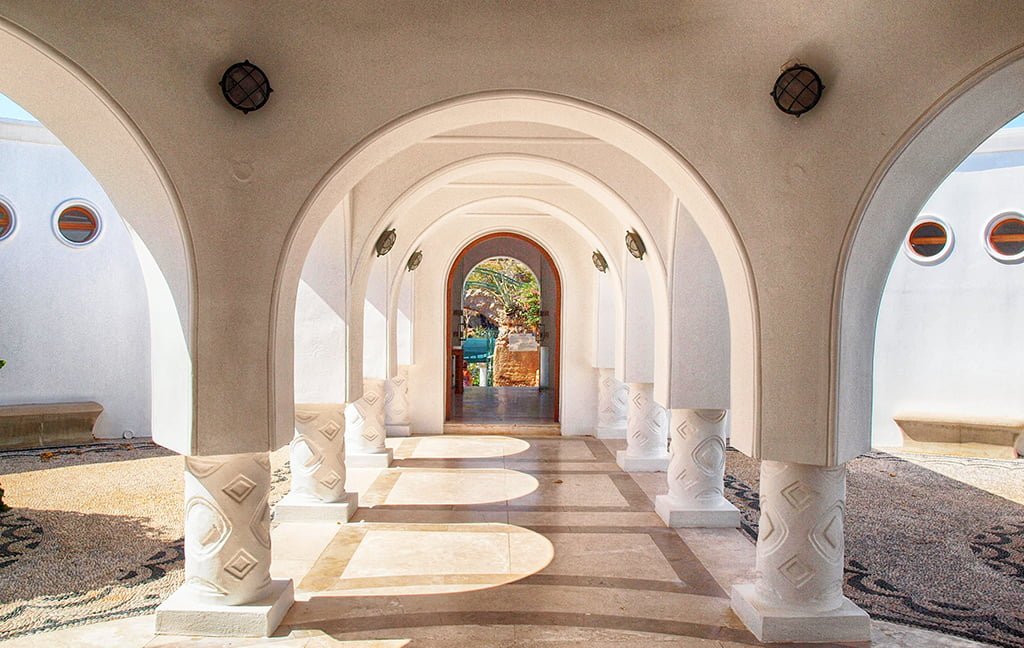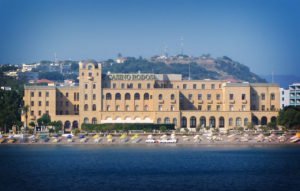
The Italian Architecture in the Dodecanese

Florestano de Fausto
In the first period the Italians adopted an architectural style with historical references aiming to provide an ideal continuity with the architecture of the period of the Knights’ domination in the islands. The first buildings, such as the barracks (1924-1926), the residency (1926-1927) and the post office (1927-1928) of Rhodes by the architect Florestano de Fausto, intended to revive former styles like Renaissance and Mannerism. Aiming at creating a symbolic architecture, the architect did not use the identical forms, but used them by means of an abstraction and recomposition process. In the following buildings there was a conscious effort to use some recognizable features of local tradition, which would eventually be better incorporated in the conquered areas.
Neoclassicism developed after the 19th century in the Greek communities of the Dodecanese was excluded because it was a direct reference to Athens, the national centre of Greece. However, the Aegean tradition was downgraded as well. The Italians rather turned to the anonymous Mediterranean and Balkan tradition. The new architecture created combined Venetian and Gothic features with decorative motifs from the Dodecanese folk art as well as loans from the tradition of neighbouring Arabian Mediterranean countries. A new eclectic architectural vocabulary resulted from the mixture of all these styles. In the case of Rhodes, which was promoted and organised by the Italians as a tourist destination, eclecticism became highly exotic, thus giving the island the international air of a Mediterranean resort. The most typical example of this architecture is the Rodon Hotel, designed by Florestano de Fausto (1925-1927). At Kalithea Baths (1928-1930), designed by Pietro Lombardi, there is a more abstract style, nearer the principles of rationalism and Art Deco, developing in Italy at the time. The Kalithea complex is an interesting intervention in the natural setting of the springs thanks to the use of designed and natural open-air areas and the gradation of volumes in the different buildings. In the following decades the place became the point of reference for tourists and the ideal setting for many Greek films of the 1960s.
Town planning interventions in Rhodes and Kos are indicative of the way the Italians viewed towns. According to the master plan for the town of Rhodes, prepared by Florestano de Fausto, the public services were along the coast and outside the historical centre of the town. In a central position was Foro Italico, the necessary free space for the large public gatherings promoted by fascism, with the House of Fascism (Casa del Fascio), the tower and the speaker’s balcony.
The Fascist Period
In the second period after the proclamation of The Fascist Empire in December 1936 Mario Lago was replaced by Cesare De Vecchi, a very early leader of the Fascist party. In 1936, with the Italian conquest of Ethiopia, Benito Mussolini proclaimed Victor Emmanuel III to be the Emperor of Ethiopia – a title considered illegitimate by parts of the international community, and lasted only five years. De Vecchi found the cosmopolitan atmosphere of Rhodes too far from the nationalist one prevailing in Italy. He abolished the tribunals which following the Ottoman tradition ruled over matters related to the various religious communities; Greek newspapers were closed; Italian was imposed as the only authorised language. The new governor was not pleased with the appearance of many modern buildings and he ordered the Albergo delle Rose stripped of the ornate decorations designed by Di Fausto. De Vecchi initiated a new period in Italian architecture, aiming at giving the conquered islands the air of a Roman province. This period is characterised by abstraction and the prevalence of rationalism and modern classicism. In this period De Vecchi launches a campaign to ‘purify’ his predecessor’s architecture by restoring the facades of several public buildings.
In Rhodes the capital of their new colony as they did in Libya, Eritrea and Somalia the Italians engaged on an energetic and expensive scheme of public works to impress the natives and the world with the benefits of Fascism. In Rhodes this largely meant rebuilding the Greek New Town (Neo Chorio), removing the Ottoman additions to the medieval walled town and the ultimate fascist vanity project “rebuilding” the Palace of the Grand Masters as an Italian Borgo with a considerable addition of HRT – History Replacement Therapy. They would later demolish the houses that were built on and around the city walls during the Ottoman era. They also turned the Jewish and Ottoman cemeteries into a green zone surrounding the Medieval Town. The Italians preserved what was left from the Knights’ period, and destroyed all Ottoman buildings. Furthermore, an Institute for the study of the History and Culture of the region was established, and major infrastructure work was done to modernize Rhodes.
Neo Chorio where the Greeks lived was turned into a modern town, while the buildings of historical Rhodes were restored and the Hospital housed an archaeological museum. Among the Italian architects who designed modern Rhodes, the Roman architect Florestano di Fausto played a major role. He designed buildings which were in line with the governor’s objective of attracting a rich clientele. A very large hotel was built on the sandy beach at the very tip of the island. It was named Albergo delle Rose because the advertising campaign claimed that roses in Rhodes were in blossom ten months a year and the island was also called Isola delle Rose.
The Italian administration placed two columns at the entrance of Mandraki, which was the harbour of Ancient Rhodes, on the assumed site of the feet of the Colossus of Rhodes. This bronze statue was one of the Seven Wonders of the World: it portrayed Helios, the Greek God of the Sun; according to the traditional iconography the Colossus was spread-legged and ships passed beneath it (but today it is generally thought the statue stood on one side of the harbour). It held a torch and the head was surrounded by rays. If an inhabitant of Ancient Rhodes were to arrive at New York by sea, he would most likely think that Manhattan is a colony of Rhodes, because the Statue of Liberty has many points in common with the Colossus. Rhodes was very popular among the upper classes of cosmopolitan cities like Beirut in Lebanon and Alexandria in Egypt. Di Fausto designed a modern new market surrounded by cafés which replaced the old bazaar. Its design pleased the guests who came from Europe in search of a One Thousand and One Nights atmosphere.
On the site of the Palace of the Grand Masters De Vecchi built a gigantic mansion, meant to be used by the King or by Il Duce (the title given to Mussolini) during their visits to the island (they never went there). He placed his own coat of arms next to that of the Grand Masters and set his residence in the new palace. Today in the Neo-Chorio there is much evidence of the grandeur of the Italian scheme with an impressive assembly of somewhat oversized buildings. There is a Governor’s Residence and Municipal complex, an impressive market in neo-Moorish style, a Town hall, a National Theatre, a superb aquarium and a reconstruction of the Cathedral of the Knights of St. John, The Church of the Annunciation. The original inside the walled city was blown up when used by the Ottomans as a gunpowder store.


